Biomedical Engineering Reference
In-Depth Information
one target or image to another. The word
,
which means to jerk the reins of a horse. A saccade is a very quick and jerky movement
of the eye from one target to another.
The eye muscles are among the fastest in the human body, with a 10
saccade taking only
50 ms. The saccadic system can be thought of as a targeting system that is concerned only
with accurate and swift eye movements from one target to another without concern for
the information swept across the retina during the eye movement. During a saccade, the
visual system is turned off. After the saccade is complete, the system operates in a
closed-loop mode to ensure that the eyes reached the correct destination. Information from
the retina and muscle proprioceptors is used to correct any error between the desired and
current eye position. The saccade system operates in a closed-loop mode to reduce this
error to zero with a corrective saccade. One possible explanation of the operation of the
neural control of saccades is that the saccadic neural controller is an open-loop time-optimal
system using an internal closed-loop controller [11, 13, 16, 50]. This system does not rely on
muscle proprioceptors or real time visual feedback to ensure accuracy of movement
because the eye movements occur too fast. Instead, a complex neural network involving
the mesencephalon, cerebellum, brainstem, and cerebrum keeps track of the eye movement.
A typical experiment for recording saccades has the subject sitting before a horizontal
target display of small light emitting diodes (LEDs), as shown in Figure 13.4 (left). The
subject is instructed to maintain their eyes on the lit LED by moving their eyes as fast as
possible to avoid errors. A saccade is made by the subject when the active LED is switched
off and another LED is switched on. Eye movements can be recorded using a variety
of techniques, including electrooculography, video oculography, scleral search coil, and
saccade
originated from the French word
saquer
LED
SCREEN
FIGURE 13.4
Experimental setup to record a saccade (left) and an infrared eye movement recorder (right).
The eye movement recorder is based on the design by Engelken et al. [21].





































































